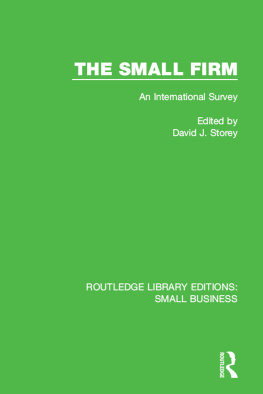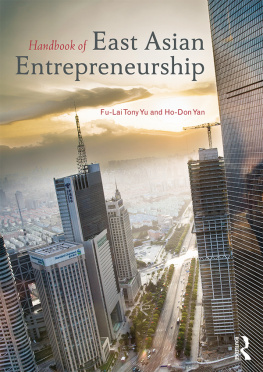
ROUTLEDGE LIBRARY EDITIONS: SMALL BUSINESS
Volume 16
THE SMALL FIRM
THE SMALL FIRM
An International Survey
Edited by
DAVID J. STOREY

First published in 1983 by Croom Helm Ltd
This edition first published in 2016
by Routledge
2 Park Square, Milton Park, Abingdon, Oxon OX14 4RN
and by Routledge
711 Third Avenue, New York, NY 10017
Routledge is an imprint of the Taylor & Francis Group, an informa business
1983 David J. Storey
All rights reserved. No part of this book may be reprinted or reproduced or utilised in any form or by any electronic, mechanical, or other means, now known or hereafter invented, including photocopying and recording, or in any information storage or retrieval system, without permission in writing from the publishers.
Trademark notice: Product or corporate names may be trademarks or registered trademarks, and are used only for identification and explanation without intent to infringe.
British Library Cataloguing in Publication Data
A catalogue record for this book is available from the British Library
ISBN: 978-1-138-67308-3 (Set)
ISBN: 978-1-315-54266-9 (Set) (ebk)
ISBN: 978-1-138-68346-4 (Volume 16) (hbk)
ISBN: 978-1-315-54447-2 (Volume 16) (ebk)
Publishers Note
The publisher has gone to great lengths to ensure the quality of this reprint but points out that some imperfections in the original copies may be apparent.
Disclaimer
The publisher has made every effort to trace copyright holders and would welcome correspondence from those they have been unable to trace.
THE SMALL FIRM
AN INTERNATIONAL SURVEY
Edited by David J. Storey

1983 David J. Storey
Croom Helm Ltd, Provident House, Burrell Row,
Beckenham, Kent BR3 1AT
Croom Helm Australia, PO Box 391,
Manuka, ACT 2603, Australia
British Library Cataloguing in Publication Data
The Small firm
1. Small business
I. Storey, David J.
338.6HD2341
ISBN 0-7099-2351-1
All rights reserved. For information, write:
St. Martins Press, Inc., 175 Fifth Avenue, New York, NY 10010
Printed in Great Britain
First published in the United States of America in 1983
Library of Congress Card Catalog Number: 83-40075
ISBN 0-312-72980-4
CONTENTS
David Storey
David Storey
James H. Thompson and Dennis R. Leyden
Douglas Anthony
Michael Cross
Brian Johns
Chris Hull
Leif Lindmark
David Storey
Tan Thiam Soon
Philip Neck
Douglas Anthony | Joint Lecturer, Centre of Japanese Studies, Division of Economic Studies, University of Sheffield, Sheffield S10 2TN, England. |
Michael Cross | Senior Research Fellow, The Technical Change Centre, 114 Cromwell Road, London SW7 4ES, England. |
Chris Hull | Research Fellow, International Institute of Management, Platz der Luftbrcke 13, D-1000 Berlin 42, Germany. |
Brian Johns | Emeritus Professor, Director Bureau of Industry Economics, Department of Industry and Commerce, Edmund Barton Building, Kings Avenue, Canberra, ACT 2600 Australia. |
Dennis R. Leyden | Dean, College of Business and Industry and Professor of Economics, Mississippi State University, P.O. Box 5288, Mississippi State, MS 39762, USA. |
Leif Lindmark | Assistant Professor, Department of Business Administration and Economics, University of Ume, S-901 87, Ume, Sweden. |
Philip Neck | Director, International Labour Organization, 7 Sardar Patel Marg, New Delhi 110021, India. |
David Storey | Senior Research Associate, Centre for Urban and Regional Development Studies, University of Newcastle upon Tyne, England. |
Tan Thiam Soon | Senior Lecturer, Business Administration, National University of Singapore, Kent Ridge, Singapore 0511. |
James H. Thompson | Professor of Economics, Bureau of Business Research, College of Business and Economics, West Virginia University, Morgantown, West Virginia 26506, USA. |
The small firm is, and probably always will be, the typical unit of production. Until recent years there had been a tendency amongst economists concerned with promoting economic growth, both in developed and in less-developed countries, to assume that a high proportion of output produced by small enterprises was indicative of low levels of economic development. The increase in industrial concentration, frequently associated with an increase in average plant size, whilst it may have led to higher profits through restricted output and to higher prices, also provided many benefits. It gave greater stability to markets, it enabled scale economies to be reaped (again at the plant level) and most importantly it ensured that large corporations were able to undertake research and development. It was this function which, it was agreed, was vital to future growth and could only be undertaken by large corporations with access to risk capital on a large scale.
Economists in the 1960s, whether they were discussing developed or less-developed economies, spoke with a perhaps surprising degree of unity on these matters, but by the mid-1970s this consensus was no longer apparent. The emphasis upon capital intensive projects in stimulating growth in developing countries became the subject of strong criticism, primarily because of the high capital costs per job created. The shortage of available capital, and the increases in the labour force which the areas experienced, meant that labour, rather than capital-intensive methods of production were viewed more favourably. Empirical research also showed that there were considerable opportunities to substitute labour for capital without losses in efficiency. The developments in intermediate technology meant that whilst there were fewer prestige projects, a considerable switching towards labour-intensive production methods took place. This served the dual function of releasing scarce capital and enabling more individuals to be employed whilst maintaining output levels.
Several developed countries also undertook a reappraisal of the role of small enterprises. In particular, Britain and Sweden began to recognise that developments in the world economy in the 1970s had led to a relative increase in the importance of small firms. The increases in oil and associated energy prices meant that capital-intensive (and hence energy-intensive) projects became less attractive. It became less beneficial to concentrate productive capacity at a single plant since the increase in distribution costs more than offset scale economies at the plant level. Increased energy prices also led to a slow-down in world trade and, since large firms were more likely to export than small, they were disproportionately affected by the international recession.
Superimposed upon the recession was the growth to industrial maturity of countries such as South Korea, Hong Kong, Taiwan as well as the continued development of Japan. These countries began to export goods which competed directly with those produced in the large-firm sector of Western Europe and North America. The inroads made into these markets by Taiwanese textiles, Hong Kong electrical goods and South Korean steel products is well documented.
Next page










